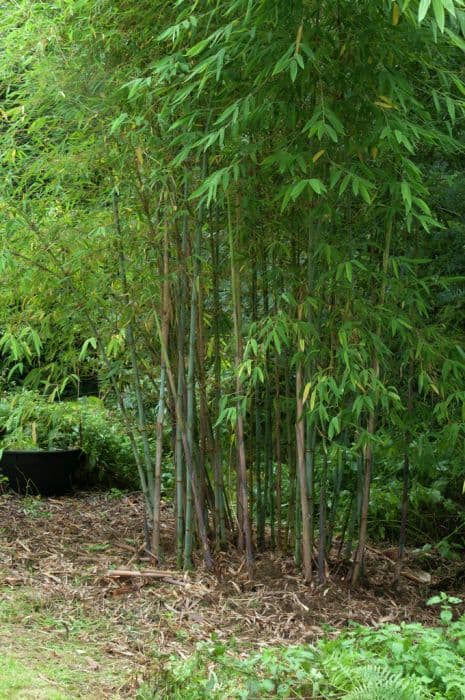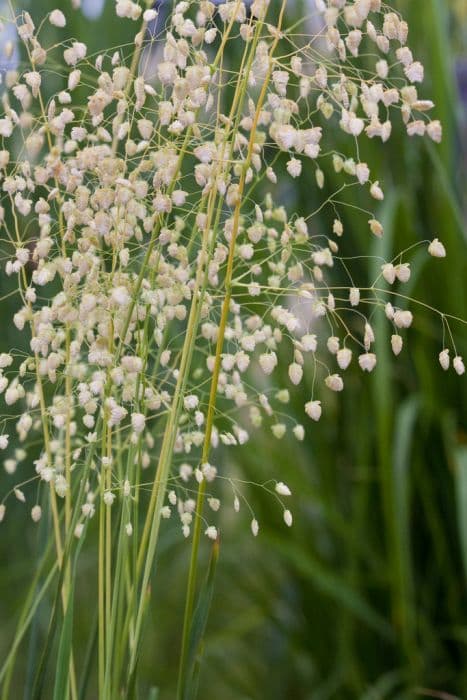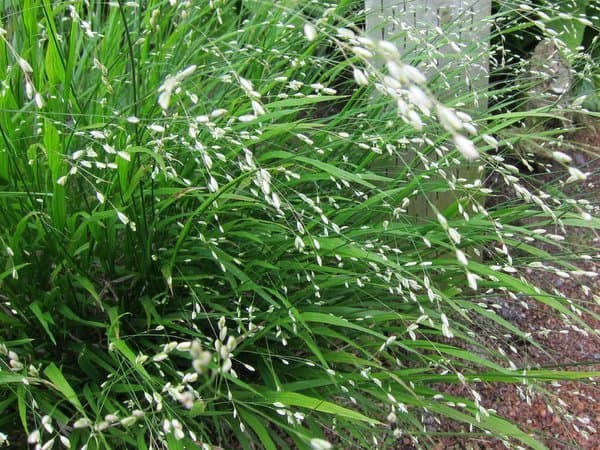Black Fountain Grass Pennisetum alopecuroides 'Black Beauty'











ABOUT
Pennisetum alopecuroides 'Black Beauty', commonly known as black fountain grass, is an ornamental plant renowned for its striking aesthetic. This cultivar is notable for its deep purplish-black foliage which forms a lush, fountain-like clump. The leaves arch gracefully, creating a rounded, mound-like appearance that adds texture and movement to the landscape. During the growing season, the plant showcases narrow, linear leaves that contribute to its dense, tufted look. As the season progresses, the black fountain grass produces bottlebrush-shaped flower spikes. These flowers are a soft, foamy purple or pinkish tone, which contrasts beautifully with the dark foliage beneath them. The blooms have a feathery and airy quality, catching the wind and adding interest to the garden with their gentle swaying. As the plant matures and the flower spikes age, they turn a lovely straw or tan color, providing extended seasonal interest well into the colder months. During the fall, the black fountain grass deepens in color and may exhibit shades of golden brown throughout its foliage, effectively capturing the essence of the autumnal palette. Overall, black fountain grass is appreciated for its contribution to garden design and landscapes, providing a unique color contrast and textural element that gardeners value for both formal and informal settings. Its elegant, weeping silhouette is particularly effective when used in mass plantings or as a specimen plant, offering a dramatic visual impact without specifics on its dimensions.
About this plant
 Names
NamesSynonyms
Black Fountain Grass, Moudry Grass.
Common names
Pennisetum alopecuroides
 Toxicity
ToxicityTo humans
Fountain grass is generally not considered toxic to humans. However, it is always advisable to practice caution and avoid ingesting plants that are not commonly recognized as food, as individuals might have allergies or sensitivities.
To pets
Fountain grass is not typically known to be toxic to pets. However, ingestion of plant material can sometimes lead to gastrointestinal upset in animals, such as vomiting or diarrhea, particularly if they consume a large amount. It's always best to keep an eye on pets around plants and prevent them from chewing on plants that are not part of their usual diet.
 Characteristics
CharacteristicsLife cycle
Perennials
Foliage type
Deciduous
Color of leaves
Green
Flower color
Pink
Height
2-3 feet (60-90 cm)
Spread
2-3 feet (60-90 cm)
Plant type
Grass
Hardiness zones
5-9
Native area
East Asia
Benefits
 General Benefits
General Benefits- Ornamental Appeal: Offers striking dark foliage that adds contrast and visual interest to landscapes.
- Low Maintenance: Requires minimal care once established, making it suitable for gardeners with limited time.
- Drought Tolerance: Can survive in dry conditions, reducing the need for frequent watering.
- Pest Resistance: Generally resistant to common garden pests, decreasing the need for chemical treatments.
- Habitat for Wildlife: Provides shelter and food for birds and small mammals, increasing local biodiversity.
- Soil Stabilization: Its root system can help prevent soil erosion, particularly on slopes.
- Seasonal Interest: Displays seasonal changes, with fluffy seed heads in the fall, enhancing year-round garden aesthetics.
- Adaptability: Thrives in a variety of soil types, making it a versatile choice for different garden situations.
- Privacy Screen: Can be used to create a natural barrier or screen, offering privacy to outdoor spaces.
 Medical Properties
Medical PropertiesThis plant is not used for medical purposes.
 Air-purifying Qualities
Air-purifying QualitiesThis plant is not specifically known for air purifying qualities.
 Other Uses
Other Uses- Fountain grass 'Black Beauty' can be used in dried floral arrangements, where its dark, purplish-black flower plumes add a unique texture and color contrast.
- This ornamental grass serves as a natural privacy screen or garden border when planted in a row, creating a dense, visual barrier.
- 'Black Beauty' functions as an erosion control plant on slopes and banks, where its root system helps stabilize the soil.
- The grass is often incorporated into habitat gardens to provide shelter and nesting material for small animals and birds.
- In landscape design, fountain grass 'Black Beauty' is used for its dramatic foliage and flower color to create a focal point or accent in garden beds.
- The rustling sound of its leaves and flowers in the wind can be harnessed to add auditory elements to a sensory garden.
- The plant’s tall and upright habit allows it to be used as a backdrop for lower-growing perennials and annuals, providing tiered garden structure.
- Fountain grass 'Black Beauty' is sometimes utilized in large containers or pots to add height and texture to balcony or patio plantings.
- Due to its attractive appearance throughout the growing season, the plant is frequently employed in seasonal displays, particularly in autumn-themed garden settings.
- In crafting, the dried seed heads of 'Black Beauty' can be sprayed with metallic or colored paint and used as part of ornamental wreaths or other decor projects.
Interesting Facts
 Feng Shui
Feng ShuiThe Black Fountain Grass is not used in Feng Shui practice.
 Zodiac Sign Compitability
Zodiac Sign CompitabilityThe Black Fountain Grass is not used in astrology practice.
 Plant Symbolism
Plant Symbolism- Resilience: Pennisetum alopecuroides 'Black Beauty', commonly known as fountain grass, often symbolizes resilience for its ability to thrive in various conditions and bounce back from the effects of extreme weather.
- Flexibility: The flowing nature of fountain grass also suggests flexibility, as it sways gracefully with the wind without breaking, reminding us of the importance of adapting to life's challenges.
- Elegance: With its unique deep purple or black foliage and attractive fluffy flower heads, fountain grass is often associated with elegance and beauty in the garden landscape.
- Privacy: As fountain grass can grow in dense clumps, it is sometimes symbolic of the need for privacy or creating personal space, as it can effectively screen areas in the garden.
- Boundaries: Similarly, it can symbolize the setting of boundaries, with its growth pattern demonstrating how to define edges and territories naturally and aesthetically.
 Water
WaterBlack Fountain Grass should be watered once a week, allowing the soil to dry out slightly between waterings. During hot summers or dry spells, you may need to increase watering frequency. A deep watering that uses about 1-2 gallons per plant is ideal to ensure that moisture reaches the roots. Adjust the amount based on the plant's size and the weather. Overwatering or allowing the plant to sit in water can lead to root rot, so ensure good drainage.
 Light
LightBlack Fountain Grass thrives in full sun conditions, meaning it should receive at least 6 hours of direct sunlight per day. It can also tolerate partial shade, but its flowering might be reduced. The best spot for this ornamental grass would be an open area that is not overshadowed by taller plants or structures.
 Temperature
TemperatureBlack Fountain Grass is hardy and can tolerate a wide temperature range. It can survive in temperatures as low as 20 degrees Fahrenheit but prefers temperatures between 60 to 90 degrees Fahrenheit for optimal growth. It is not frost-tolerant, so in areas with cold winters, it should be protected or treated as an annual.
 Pruning
PruningPrune Black Fountain Grass in late winter before new growth begins to remove old, dead foliage and make room for fresh growth. Pruning once a year is sufficient. The best time for pruning is just before the last frost of the season or when temperatures consistently stay above freezing. This will help maintain the plant's shape and encourage more vigorous growth in the spring.
 Cleaning
CleaningAs needed
 Soil
SoilFountain Grass prefers well-draining soil with a loamy or sandy texture and a neutral to slightly acidic pH of 5.8 to 7.0. A mix of two parts garden soil, one part sand or perlite, and one part organic compost or well-rotted manure will create an ideal environment for robust growth.
 Repotting
RepottingFountain Grass grown in containers may require repotting every 2 to 3 years to ensure it has enough space to grow. Repotting is best done in the spring before new growth begins.
 Humidity & Misting
Humidity & MistingFountain Grass is tolerant of a wide range of humidity levels and does not require specific humidity conditions to thrive, making it adaptable to various outdoor environments.
 Suitable locations
Suitable locationsIndoor
Place in bright light and avoid overcrowding.
Outdoor
Full sun, well-drained soil, space 2-3 feet apart.
Hardiness zone
5-9 USDA
 Life cycle
Life cyclePennisetum alopecuroides 'Black Beauty', commonly known as Black Fountain Grass, begins its life as a seed, which, after germination, develops into a small seedling. The seedling grows and forms clumps of narrow, arching foliage displaying its characteristic dark purplish-black color, entering a vegetative growth stage. As the plant matures, it produces tall, brush-like inflorescences in late summer to fall, marking the reproductive phase where it can produce seeds for dispersal. Following seed set, the plant can enter a period of dormancy during the colder months, where it rests and conserves energy, potentially dying back to the ground in frost-prone areas. With the return of warm temperatures in spring, Black Fountain Grass breaks dormancy and resumes growth, completing its perennial cycle. During its life, it may also spread through clump division, where parts of the root system give rise to new plants, contributing to its propagation and survival.
 Propogation
PropogationPropogation time
Spring to Summer
Propogation: The Pennisetum alopecuroides 'Black Beauty', commonly known as Black Fountain Grass, is typically propagated by division, which is the most popular method for this ornamental grass. The best time to propagate is in the spring, as the grass comes out of dormancy and begins to show new growth. To propagate by division, one should dig up the plant, carefully splitting the root ball into smaller sections, ensuring each section has a decent amount of roots and shoots. These divisions can then be replanted immediately into well-preparing planting holes, spaced adequately to allow room for growth. It's important to keep the transplants well-watered until they are established, which means keeping the soil consistently moist but not waterlogged.









